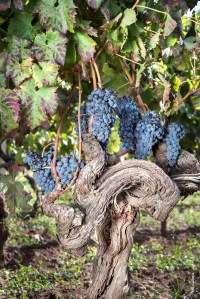We often hear the term “old vines” in reference to wine, which almost always applies to limited-edition bottlings from a special vineyard or plot. But what exactly do these words mean, and more important, how do older vines affect the wine we drink? You may see it on a label or list as vielles vignes, viñas viejas, vigne vecchie, alte ruben or just plain old old vines depending on where it’s from, but these terms mean the same thing: the vines that the grapes grew on have been around longer than most of the other vines at that winery or in that vineyard. “What constitutes an ‘old’ vine can vary by region, variety, and viticultural tradition. In some regions, 35 years might be considered old, while in others, vines might need to be 50 or more years old to earn that status,” says Master of Wine Sarah Abbott, co-founder of . “The goal isn’t rigid uniformity, but rather a shared understanding that vine age matters and deserves recognition.”
One thing that everyone can agree on is that old vines improve the flavor and complexity of wine. Fabrice Brunel, owner of Domaine in makes a wine called Cuvée Centenairewhich he first produced in 1989 to celebrate the 100th anniversary of the planting of his Farguerol plot, which had previously been decimated by phylloxera. Made with 95 percent Grenache and 5 percent Mourvedre from the oldest vines of the plot (on average, 130 years old), Brunel describes the wine as “more complex, structured, deeper, and with a longer finish.” He credits water-retaining qualities of the vineyard’s clay soils for preventing the vines from suffering during long, dry summers. Thanks to this, the vines have survived into a ripe old age and the wine he makes achieves perfect balance.
Older vines have lower yields, or fewer bunches and grapes per plant, which translates to deeper concentration in the finished wine. At in Campo de Borja, Spain, Miguel Sanmartin works with vines that are between 30 and 100 years old from eight high-elevation vineyards around the city of Tabuenca. The winery’s top three bottlings are all made with Garnacha grapes from older plantings: Veratón from 30- to 50-year-old vines, Alto Moncayo from vines aged 40 to 70 years, and Aquilón from 65- to 100-year-old vines. Sanmartin says the average yields for his 15-year-old vines are almost four times greater than these older plantings. “In general, wines produced from old vines have softer tannins, bigger roundness, and offer a greater complexity that exhibits more potency and depth,” he says, and points to their balanced nature and well-integrated acidity as qualities that lend themselves to long aging in the bottle.

An old vine in Beaujolais
Vineyards planted with older vines need to be handled differently than those with younger vegetation. At Chile’s , technical director Andrea Leon cultivates 99 acres of vines planted between 1907 and 1980 among 536 acres of mainly Cabernet Sauvignon and Carmenere with smaller amounts of Semillon and Cabernet Franc in one of the country’s most celebrated vineyards, Clos Apalta. “What sets old vines apart is the need for carefully considered pruning, as each plant has a unique and distinct structure,” she says. “Minimal canopy management or green harvesting is required, as these vines are well-adapted to the Apalta conditions after so many years.” The goal is to is to extract the best qualities from each parcel, allowing the vineyard to express itself fully, which carries over into the winemaking process. “We aim for elegance, texture, and density, using gentle extraction methods,” she says, which results in finished wine characterized by remarkable balance, intense aromatic expression, and a refined tannic structure.
Across the Andes in , Argentina, winemaker Rodrigo Romero harvests 70-year-old vines for Pascual Toso Alta Cabernet Sauvignon, which is noted for its depth, complexity, and concentration. For Romero, young vines provide fresh fruit flavor, but often make wine lacking the mature tannins and good acidity he wants for a bottle that will age gracefully. “For great wines, we need old vineyards,” he says.
Old vines exist almost everywhere that grapes are grown. Abbott’s Old Vine Conference membership spans over 20 countries and includes some of the most iconic wine regions in South Africa, Australia, Chile, France, Italy, Spain, and the United States. And while there is no global or legally binding definition of how many years is considered old enough, some countries and regions are setting their own standards. “There is a growing movement toward formalizing definitions; South Africa’s Old Vine Project, for instance, uses 35 years as its threshold,” she says.

You can find these beautiful gnarled beasts all around the world.
Fabio Gambina
Some of the oldest vines in the United States are in which is estimated to produce 40 percent of all the grown in the state. While much of the Zinfandel from the region is noted for its bold fruit and black pepper flavors, older vines and the type of soil they are growing in can change that profile significantly. At Ironstone Vineyards, director of winemaking Steve Millier crafts Ironstone Lodi Rous Vineyard Reserve Ancient Vine Zinfandel from a plot planted in 1909, making these some of the oldest Zinfandel vines in Lodi. Millier says the combination of the ancient vines and the delicate style of the grapes results in a wine that’s distinctively floral, elegant, and nuanced. “This wine showcases the terroir of the sandy soils and the warmth of the surrounding sunshine,” he says. It’s a pretty, delicate style that reveals the true character of Zinfandel.”
Abbott points out that the root systems of old vines are well established, which can lead to greater resilience in challenging vintages and more consistent quality. Their deeper root systems can reach further down into the soil to access groundwater, which makes them resistant to drought in an ever-changing environment. Having already adapted to the specific qualities of the soil and climate in which they have grown, they are more likely to resist pests they have already encountered and to continue to adapt as vineyard conditions evolve. “Beyond quality, there’s an emotional and cultural value too; these vines are living history, often planted by previous generations, and they connect us to a deeper story,” Abbot says. Gnarled, thick vines are akin to wise elders among us; beyond our thanks for the wine they produce, they deserve our respect and admiration for what they have endured.
Authors
-
Mike DeSimone and Jeff Jenssen
Mike DeSimone and Jeff Jenssen, also known as the World Wine Guys, are wine, spirits, food, and travel writers, educators, and hosts. They have been featured guests on the Today Show, The Martha…
Credit: robbreport.com











